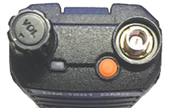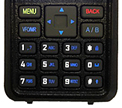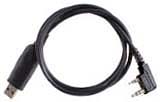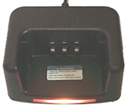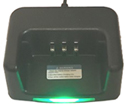|
DM-1801 General Description
The DM-1801 is a dual band (UHF / VHF) handheld with both Analog FM and DMR Tier 2 capability. In the Box Included with the radio are the: - 7.4V 2200mAh Li-Ion Battery - Charger base & AC adapter - Belt clip - Antenna – 5 3/4" (14.5cm) - Earpiece/microphone - Lanyard - 99 page User Guide – English General Description - VHF and UHF - DMR / FM - 136-174 and 400-470MHz - 1W / 5W transmit - 1024 channels - 16 channels / zone - Part 90 2AJGM-1801 Enclosure The case measures 5.1 x 2.4 x 1.3" (130 x 60 x 32mm) and weighs in at 9.0oz (255) with battery and antenna installed. The case has a solid feel, weight, and durability that fits well in my large hand. The buttons however are small and require a firm push. The right side of the radio has a cable jack is fit for the standard K1 connector, however the actual programming cable is unique.
Transmitter The frequency range is VHF 136-174 and UHF 400-470 MHz. Along with DMR, the radio also supports both Wide and Narrowband FM. OTA audio reports are good with plenty of audio although lacking some low frequency response. Power levels on analog were pretty close to specs. Power readings taken with a calibrated Bird Termaline.
Receiver & Audio The receiver sensitivity was good on both VHF and UHF, but the quality left a little to be desired. The audio was on the high pitched side. Scanning & Monitor Mode Along with the scanning function, there is also a Monitor mode which allows you to monitor all talk group activity on the time slot. This is also referred to as the promiscuous mode. Antenna The included antenna is 5 3/4" (14.5cm) long and is terminated with an SMA-Female connector. The performance of the antenna was good.
The radio has a two color display allowing 9 large characters per line. The background is light blue with darker Blue Gray foreground. The screen size is .75" x 1.3" with good resolution. Note: The 1801 is not capable of storing the DMR User DB.
Programming The DM1801 can be programmed by either software or from the front panel, however I highly recommend using a PC. Unlike analog that requires frequency and CTCSS tone, there are many other parameters involved and diagnostics can be very time consuming. If you are entering the world of DMR for the first time, I highly recommend downloading a 'starter' code plug template and building from there. It's a little time consuming to start, but once you understand and become familiar with the flow, it's not that difficult to tackle. Note: When programming Analog channels, the software defaults to 12.5kHz bandwidth. The standard for analog is 25.0kHz. If not changed to 25.0, the analog audio will be very low. The software is set up to allow the basic commands needed to accessed with some of the more advanced functions locked out. These functions can be easily unlocked by simply selecting Control / Alt / Shift / F11 and entering "DMR1801". Keypad The keypad numbers are a bit small for large fingers. The square with the four arrows shown below is only a half inch across and extremely difficult to maneuver requiring a good bit of preasure. My thumb covers all four directions at one time. Although the Up/Down The four control buttons on the keypad (MENU, BACK, VFO/MR and A/B) are not programmable. Their functions are fixed.
Programmable Keys Along with the PTT button, there are two programmable keys on the side as well as one on the top. Each has a long and short press option for a total of six possible options. There are three side buttons as well as the P1 / P2 buttons shown above that are programmable.
Software The factory software is fairly straight forward, but again, contains terminology that may require a bit of research. A little intimidating at first, but call it a basic learning experience. The software is set up to allow the basic commands needed to accessed with some of the more advanced functions locked out. These functions can be easily unlocked by simply selecting Control / Alt / Shift / F11 and entering "DMR1801". Note: With Firmware v2.1.9 and later, it is no longer required to have a separate Rx Group list for every contact. When Rx Group List is set to NONE, the receive Talk Group will default to the Transmit Contact. Prior FW versions required a double entry when programming. Note: When programming an analog channel, the default bandwidth is 12.5kHz (rather than 25kHz). It is easy to miss and your analog audio will be extremely low if not corrected. Firmware The DM-1801 was introduced in late summer 2018, however the firmware is fully upgradable. When changes and upgrades are available, the firmware can be upgraded with a standard Windows PC. As of this updated review, a new firmware has been released (v2.1.9). Programming Cable The programming cable resembles the cable used on many ham transceivers, but that's where the similarity ends. The programming UART chip is in the radio, not the cable. Although the cables looks the same and used the same connectors, you must use the cables provided with the radio.
Battery and Charger The 2200 mAh battery provides a full days use when the battery is fully charged. Charge cycle is approximately 6 hours. The LED bar on the front of the charger is unmistakable. Bright Red when charging, and Bright Green when either fully charged. If there is no radio in the charger, the indicator light alternates from red to green.
Accessories Although the programming cable above is not compatible, accessories such as Spkr/Micr are. I use a QHM-22 and the reports are excellent. Transmit Audio Audio reports on the DM-1801 are very good. The radio does not have an audio adjustment, so the gain is fixed. I receive the best audio reports when I rest radio on my cheek, holding the radio approximately one inch (2.5cm) away, speaking across the front of the radio. This produces full, clear, and undistorted audio. Tutorial If you are new to DMR, here is a link to a tutorial that I put together to assist the new user. It explains the basics and hopefully makes you a bit more comfortable with DMR. TUTORIAL Conclusion The DM-1801 has 'potential' as a low end starter radio, but still in need of a few updates at this time. If you are looking for special features, this radio has none. Pros: - Dual Band Tier II DMR and Analog - Solid Build and Feel - Decent overall performance Cons: - Small keypad buttons, hard to press - There is no channel knob - Only 9 characters per LCD line - Unassigned arrow keys - Software needs some refinement Note: This equipment was received for the purpose of a fair and unbiased review. All findings are factual based on the equipment I received. Any issues found have been reported both here and back to the seller or manufacturer. Available on: Amazon - DM1801 QHM-22 (May be rebranded under another distributor)
|
BTECH 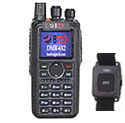 DMR6X2 PRO Dual Band (Review) Anytone 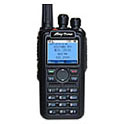 D878UV II+ Dual Band (Review)  D578UV Series Mobiles Hotspot  SkyBridge MAX (Review) Ailunce 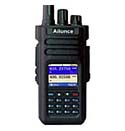 HD1 / GPS (Review) Amplifiers  BTECH DMR Amps UHF VHF (Review) Repeaters  Ham / GMRS Commercial Repeaters Duplexers |


